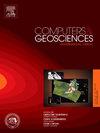Data space inversion for efficient predictions and uncertainty quantification for geothermal models
IF 4.4
2区 地球科学
Q1 COMPUTER SCIENCE, INTERDISCIPLINARY APPLICATIONS
引用次数: 0
Abstract
The ability to make accurate predictions with quantified uncertainty provides a crucial foundation for the successful management of a geothermal reservoir. Conventional approaches for making predictions using geothermal reservoir models involve estimating unknown model parameters using field data, then propagating the uncertainty in these estimates through to the predictive quantities of interest. However, the unknown parameters are not always of direct interest; instead, the predictions are of primary importance. Data space inversion (DSI) is an alternative methodology that allows for the efficient estimation of predictive quantities of interest, with quantified uncertainty, that avoids the need to estimate model parameters entirely. In this paper, we illustrate the applicability of DSI to geothermal reservoir modelling. We first review the processes of model calibration, prediction and uncertainty quantification from a Bayesian perspective, and introduce data space inversion as a simple, efficient technique for approximating the posterior predictive distribution. We then introduce a modification of the typical DSI algorithm that allows us to sample directly and efficiently from the DSI approximation to the posterior predictive distribution, and apply the algorithm to two model problems in geothermal reservoir modelling. We evaluate the accuracy and efficiency of our DSI algorithm relative to other common methods for uncertainty quantification and study how the number of reservoir model simulations affects the resulting approximation to the posterior predictive distribution. Our results demonstrate that data space inversion is a robust and efficient technique for making predictions with quantified uncertainty using geothermal reservoir models, providing a useful alternative to more conventional approaches.
地热模型有效预测和不确定性量化的数据空间反演
在量化不确定性的情况下进行准确预测的能力为地热储层的成功管理提供了重要的基础。使用地热储层模型进行预测的传统方法包括使用现场数据估计未知模型参数,然后将这些估计中的不确定性传播到感兴趣的预测量。然而,未知参数并不总是有直接意义;相反,预测才是最重要的。数据空间反演(Data space inversion, DSI)是一种替代方法,它允许对感兴趣的预测量进行有效估计,具有量化的不确定性,从而避免了完全估计模型参数的需要。在本文中,我们说明了DSI在地热储层建模中的适用性。我们首先从贝叶斯的角度回顾了模型校准、预测和不确定性量化的过程,并介绍了数据空间反演作为一种简单、有效的逼近后验预测分布的技术。然后,我们对典型的DSI算法进行了改进,使我们能够从DSI近似直接有效地采样到后验预测分布,并将该算法应用于地热储层建模中的两个模型问题。相对于其他常用的不确定性量化方法,我们评估了DSI算法的准确性和效率,并研究了油藏模型模拟的数量如何影响对后验预测分布的近似。我们的研究结果表明,数据空间反演是一种稳健而有效的技术,可以利用地热储层模型进行量化不确定性预测,为更传统的方法提供了一种有用的替代方案。
本文章由计算机程序翻译,如有差异,请以英文原文为准。
求助全文
约1分钟内获得全文
求助全文
来源期刊

Computers & Geosciences
地学-地球科学综合
CiteScore
9.30
自引率
6.80%
发文量
164
审稿时长
3.4 months
期刊介绍:
Computers & Geosciences publishes high impact, original research at the interface between Computer Sciences and Geosciences. Publications should apply modern computer science paradigms, whether computational or informatics-based, to address problems in the geosciences.
 求助内容:
求助内容: 应助结果提醒方式:
应助结果提醒方式:


